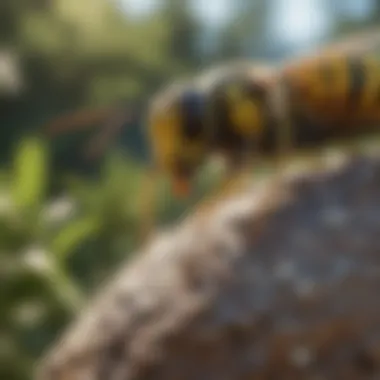Safe and Effective Wasp Nest Removal Strategies


Intro
Wasp nests can pose significant challenges for homeowners. Addressing them safely is crucial, given the aggressive nature of these insects. Understanding both wasp behavior and effective removal techniques is essential for ensuring a safe home environment.
Understanding Pests
Wasp nests fall under the umbrella of pests that can disrupt everyday life.
Definition of Pests
Pest is a term used to describe organisms that undermine human activities or interests. These can include insects, rodents, and larger wildlife. In the case of wasps, they can lead to uncomfortable encounters, painful stings, or even allergic reactions in sensitive individuals.
Importance of Pest Identification
Identifying the type of pest is fundamental in determining an appropriate response. Not all wasps are dangerous, but many are. Knowing when a wasp nest should be removed versus when it can remain undisturbed is vital. Educating oneself on the specifics of wasp behavior is necessary.
Prevention Techniques
An ounce of prevention is worth a pound of cure. Taking proactive measures can avert the formation of a wasp nest in the first place.
Home and Garden Preventative Measures
- Seal cracks and openings around your home, especially near vents and doors.
- Keep food covered outdoors to avoid attracting wasps.
- Maintain cleanliness in your garden, removing fallen fruits and other potential food sources.
Seasonal Prevention Tips
- Spring: Inspect your property for signs of wasp activity, and act swiftly before nests form.
- Summer: Regularly trim trees and bushes, reducing potential nesting sites.
- Fall: Remove any visible nests before the onset of colder weather, as wasps seek shelter.
Eco-Friendly Pest Control Solutions
Utilizing sustainable practices can minimize environmental harm while addressing pest problems.
Overview of Sustainable Practices
This entails avoiding chemicals that could harm beneficial insects and the ecosystem. Relying on traps or natural repellents serves as eco-conscious alternatives.
Natural Remedies and Their Effectiveness
Some methods have shown effectiveness in deterring wasps, such as:
- Peppermint oil spray: Mix water with several drops of peppermint oil and spray in areas of wasp activity.
- Vinegar traps: Fill a bottle with apple cider vinegar to attract and trap wasps.
Safety should always be your top priority when dealing with pests. Never attempt to remove a nest without proper precautions and knowledge.
To conclude, addressing a wasp nest is no small task. With preparation and informed strategies, it is possible to tackle the issue while safeguarding your home and family.
Understanding Wasp Behavior
Understanding wasp behavior is critical when dealing with a wasp nest. This knowledge can inform effective removal strategies while minimizing risks. Wasps can be aggressive and unpredictable, particularly when their nests are threatened. By comprehending their habits, homeowners can approach the situation with a clear plan, ensuring safety for both themselves and the wasps involved.
Types of Wasps
Yellowjackets
Yellowjackets are one of the most common wasp species found in North America. They are highly social insects known for their aggressive nature. This aggressiveness is a key factor in understanding how to safely remove their nests. Yellowjackets have a distinctive black and yellow coloration, which makes them easily recognizable.
One of the most notable features of Yellowjackets is their nesting behavior. They often build their nests underground or in wall cavities, making detection challenging. This aspect can be disadvantageous because it increases the risk of surprise encounters. Knowing the specific traits of Yellowjackets helps in planning an effective removal strategy that reduces the chances of getting stung.
Paper Wasps
Paper wasps are less aggressive compared to Yellowjackets, but they can still become defensive when provoked. They create a unique umbrella-shaped nest made from plant fibers, which they chew into a papery material. This construction method makes their nests identifiable and often found hanging from eaves or trees.
Paper wasps not only have a distinct nesting structure but also play a role in the ecosystem as pollinators. However, their stinging capabilities should not be underestimated. Understanding their behavior can help homeowners differentiate between a nuisance and a true danger when deciding on removal strategies.


Bald-Faced Hornets
Bald-faced hornets are a type of wasp known for their striking black and white coloration. They build large, characteristic nests high in trees or on structures. This unique nesting habit makes them easier to spot but often results in being closer to human activities.
The presence of bald-faced hornets can be alarming due to their aggressive defense of the nest. Their nests are also quite large, containing numerous individuals, which can pose a greater threat during removal. Recognizing their traits is essential for understanding the level of caution required when addressing such infestations.
Wasp Nest Construction
Nesting Materials
Nesting materials are a defining factor in how wasps construct their homes. Wasps utilize fibers from wood, plants, and sometimes paper to build their nests. The choice of materials is integral to nest structural integrity and can influence the removal process. For example, nests made from paper are easier to dismantle compared to those constructed from harder substances. Recognizing these materials can provide insights into the best techniques for removal and safety.
Location Preferences
Wasps have distinct preferences for nesting locations that can vary by species. Yellowjackets often choose concealed areas such as underground spaces, while paper wasps prefer to hang nests from eaves or branches. This information is valuable for homeowners to locate nests before they become too large. Understanding their location preferences can simplify the identification process and provides guidance on the best times to observe during non-peak activity hours.
Seasonal Activity
As seasons change, so does wasp activity. Spring and early summer see increasing wasp populations, as new queens emerge and establish nests. By late summer, these nests can reach their peak size and activity, which is when removal becomes most necessary. Knowing seasonal patterns is crucial for planning effective removal while ensuring safety measures are in place.
Aggressive Behavior Triggers
Nesting Stress
Nesting stress can trigger aggressive behavior in wasps. If their nest is disturbed, they perceive a direct threat to their colony, prompting defensive actions. Understanding this trigger is essential for those considering DIY removal methods. Approaching a nest without preparation can lead to unexpected stings. Recognizing signs of distress in the colony can help homeowners assess the risk before taking action.
Environmental Disturbances
Environmental disturbances such as noise or sudden movements can provoke aggressive responses. Wasps are sensitive and will react to perceived threats in their surroundings. A lack of awareness regarding these disturbances often leads to dangerous situations. It is important for individuals to conduct any assessments quietly to avoid eliciting hostile behaviors from the wasps, enabling a safer removal process.
Chemical Signals
Chemical signals play a critical role in wasp behavior. When a wasp feels threatened, it releases pheromones that can alert other wasps to the danger. This can result in a rapid increase in aggressive behavior from multiple wasps in the vicinity. Recognizing the implications of these chemical signals can significantly influence the decisions homeowners make during a nest removal situation.
Assessing the Situation
Assessing the situation is an essential step before attempting to remove a wasp nest. It is crucial for ensuring the safety of all individuals involved. Understanding the potential risks and having a clear plan helps in minimizing exposure to wasps. Proper assessment can also determine the necessity of professional assistance or if a DIY approach is appropriate.
Safety First
Personal Protective Equipment
Personal Protective Equipment (PPE) serves as the first line of defense against wasp stings. Consider heavy-duty clothing, which covers arms and legs, and a beekeeper's veil to protect the face. Gloves should also be thick and long to prevent any point of entry for stingers. The key characteristic of PPE is its ability to deter wasps from landing on the skin.
Using appropriate PPE reduces the risk of serious injury, making it a visible choice in wasp removal. However, one disadvantage is that PPE can be cumbersome, making it somewhat uncomfortable during the removal process.
Creating a Safe Perimeter
Creating a safe perimeter is vital. This involves establishing a zone around the nest that is clear of people and pets. The key characteristic of a safe perimeter is the distance maintained from the nest. Typically, keeping at least 20 to 30 feet away is advisable. This distance allows for reduced risk of alarming the wasps. While beneficial for safety, a disadvantage arises if the nest is in a hard-to-access area, as this may complicate the removal process.
Identifying Nest Size
Identifying the size of the wasp nest plays a crucial role in assessing how to proceed with removal. A small nest might not pose as much of a threat when compared to a larger one. The key characteristic of assessing nest size is determining the number of wasps present. A larger nest indicates a greater risk of attack and requires more caution. In contrast, smaller nests may allow for a DIY removal. However, misjudging the nest size could lead to significant dangers during removal efforts.
Knowing When to Seek Professional Help
Physical Limitations
Understanding physical limitations is paramount in this process. If an individual experiences health issues such as allergies to insect stings or mobility restrictions, these cannot be overlooked. This aspect is particularly relevant as it promotes safety first. Knowing personal limits helps to assess whether the task is manageable. If limitations exist, it may be best to seek expert assistance, avoiding potential complications.
Extent of Wasp Infestation
Assessing the extent of the wasp infestation is necessary for determining the right approach for removal. A small number of wasps may indicate that you can handle it independently. Conversely, large colonies require skills that only professionals may possess. The key characteristic of infestation extent lies in determining the number of wasps and their behavior patterns. Ignoring this could endanger those involved in removal.
Legal Considerations


Legal considerations can affect your decision on how to handle wasp removal. This includes local regulations regarding pest control. Many areas may have laws that prohibit certain extermination practices. Knowing this is beneficial as it allows homeowners to perform actions that are compliant with regulations. A unique feature of this consideration is the potential consequences of illegal actions, which can lead to fines or other penalties. So it is prudent to always check with local authorities before proceeding with removal.
Preparation for Removal
Preparation is critical when dealing with a wasp nest. Proper planning not only increases the likelihood of a successful removal but also minimizes the risks involved. Without adequate preparation, individuals may expose themselves to aggressive wasps and potential stings. Thus, understanding how to prepare can significantly enhance safety and effectiveness during the removal process.
Time of Day Considerations
Optimal Removal Hours
The time chosen for removal plays a vital role in the success of the task. Optimal removal hours typically fall early in the morning or late in the evening. Wasps are less active during these periods. This characteristic makes these times beneficial for homeowners. Reduced activity diminishes the chances of confrontation with the wasps.
However, caution is still necessary. Even during these hours, some wasps may be alert. It’s important to execute the removal quickly and methodically. Planning around these times allows for a safer approach to addressing the nest.
Wasp Activity Patterns
Understanding wasp activity patterns contributes to safe removal strategies. Wasps tend to be most active during warm daylight hours. Recognizing this behavior helps individuals choose appropriate times for removal. The key advantage here is executing the task when risks of attack are minimized.
It is also beneficial to observe the nest prior to removal. Monitoring when the wasps enter or exit can provide insights into peak activity times. By knowing these patterns, homeowners can better time their actions, reducing the likelihood of disturbance.
Gathering Required Tools and Materials
Protective Gear
The importance of protective gear cannot be overstated. Proper gear protects against wasp stings, which can be painful and sometimes serious. Essential items include long sleeves, gloves, and a face shield. This safety measure is particularly crucial if the nest is large or the wasp species is known to be aggressive.
Using high-quality protective gear offers significant advantages. It creates a barrier between the individual and the wasps, helping to prevent stings during removal. This preparation step is fundamental for safety during potentially dangerous situations.
Removal Tools
The right tools for removal can significantly impact the process’s effectiveness. Standard tools might include a spray can with a long nozzle or a vacuum. These devices help ensure a safe distance from the nest.
Specific features of removal tools include reach and precision. Long nozzles allow users to apply insecticide while remaining at a safe distance. However, choosing the wrong tool can lead to ineffective removal or increased risk of being stung. Therefore, selecting appropriate, reliable tools is a fundamental part of the preparation process.
Treatment Solutions
Choosing effective treatment solutions is integral for successful removal. Chemical insecticides are often popular choices. They effectively eliminate wasps on contact, which provides immediate results. However, caution is necessary. Users should ensure the insecticide is safe for residential use and follow all instructions carefully.
Natural or non-chemical solutions exist as alternatives. Soap and water mixtures can immobilize wasps. While they are less aggressive, they may require more time and effort to apply effectively. Understanding the unique features and potential drawbacks of various solutions helps homeowners select the best option for their particular situation.
Methods for Wasp Nest Removal
Removing a wasp nest requires a thoughtful approach, focusing on safety and effectiveness. Understanding the methods available can greatly influence the outcome of your efforts. Using the right techniques ensures that you minimize risks to yourself and others around you. Whether you choose chemical or non-chemical strategies, knowing how they work is essential. This knowledge allows homeowners to decide the best course of action based on their specific circumstances. The effectiveness of each method plays a key role in resolving the issue without unnecessary complications.
Chemical Approach
Types of Insecticides
Chemical insecticides are often the go-to choice for many homeowners facing infestations. These products are specifically designed to eliminate pests like wasps effectively. Common insecticides used include pyrethroids, which are synthetic versions of natural compounds found in chrysanthemum flowers. Their rapid action and ability to target wasps without spreading toxicity to the environment make them a preferred option.
However, homeowners must carefully consider the potential hazards of using these products. Proper usage is crucial. Over-application can lead to adverse environmental effects. Additionally, applying insecticides in a non-targeted way may harm beneficial insects.
Application Techniques
There are several established techniques when it comes to applying chemical insecticides. It is essential to know the correct technique to achieve the best results. Spray applications are popular as they allow for targeted treatment. A long-range sprayer can help keep distance from the nest while effectively delivering the product.
Using nocturnal application is another key characteristic. Wasps are less active during the night, decreasing the risk of stings. However, ensure that you are equipped adequately. Protect your face and skin with proper personal protective equipment.
Post-Removal Cleanup
Post-removal cleanup is an indispensable step that often gets overlooked. This process involves removing all remnants of the nest and any remaining insecticide traces. It is beneficial for several reasons. First, it helps prevent attracting other pests. Second, it ensures a safe environment for pets and children playing in the yard.
A careful cleanup routine includes wearing gloves and disposing of insect debris properly. Allowing debris to linger can invite new pests to establish themselves. Additionally, it is wise to wash any surfaces that may have come in contact with insecticides to eliminate harmful residues.


Non-Chemical Approaches
Soap and Water Method
The soap and water method is a simple and effective alternative to chemical insecticides. This approach works by blocking the breathing pores (spiracles) of the wasps, leading to suffocation. It is an effective method for small nests, providing a straightforward way to eliminate a few insects quietly without harsh chemicals.
One significant advantage is that it poses less risk to the environment. Ingredients are often household staples and are safer to use around pets and children. However, this method may require several applications depending on the size of the nest and activity level.
Trapping Techniques
Trapping can serve as an effective strategy, especially in the late summer and early fall months when can be an issue. Various types of traps are available, including commercial options and homemade ones using sweet or protein bait.
The traps lure wasps in, making it a passive method of infestation control. They reduce the population before it becomes a full-blown problem. A notable downside is that trapping alone may not eradicate an established nest but can serve as a preventative measure.
Natural Deterrents
Natural deterrents offer a greener alternative for homeowners concerned about the environmental impact. Substances like peppermint oil can create an unbearable atmosphere for wasps, often leading them to relocate their nests.
Using natural deterrents can be a beneficial option, especially in residential areas. However, they often take longer to show results compared to chemical options. Consistency in application is key to seeing the desired outcomes. Overall, these methods may not be as effective for large infestations but can be a part of an integrated pest management plan.
Effective wasp control requires careful planning. Choose methods suitable for your situation to ensure a successful removal.
Post-Removal Considerations
After the removal of a wasp nest, several vital steps ensure not only the immediate resolution of the issue but also a sustained and safe environment. Post-removal considerations help address any lingering threats from wasps and promote responsible practices that benefit both homeowners and the ecosystem. This part outlines follow-up actions and long-term strategies essential for reducing risk and fostering awareness.
Following Up on Wasp Activity
Monitoring the Area
Monitoring the area where the nest was located plays a crucial role in maintaining safety. This activity involves observing for any signs of remaining wasp activity or new nesting attempts. Regular check-ins can facilitate early detection of any returning wasps, preventing potential emergencies. A key characteristic of monitoring is its proactive nature, as it encourages you to stay vigilant in your environment.
It is beneficial because it acts as a deterrent, discouraging wasps from re-establishing their nests nearby. Unique to this aspect is the ability to identify environmental triggers that may attract wasps, allowing for timely interventions. However, it's important to note that monitoring does require consistent attention and can be time-consuming depending on the location's susceptibility to wasp activity.
Identifying New Nests
Identifying new nests is another critical follow-up task. After removal, some areas may still be attractive to wasps, leading them to build new nests. Recognizing the early signs of nest formation can help you respond quickly. A key benefit of this identification process is that it fosters a proactive rather than reactive approach to pest control.
A unique feature of this aspect is the ability to inform neighbors or community members about potential dangers. Engaging with your local community can create a more aware environment, further reducing the chances of wasp infestations. On the downside, it may require education on what new nests look like and when to take appropriate action.
Preventive Measures
Implementing preventive measures is essential after wasp removal. This includes altering the environment to make it less inviting to wasps. Key strategies may include sealing cracks and openings, maintaining a clean outdoor area, and removing food sources. The benefit of preventive measures is that they provide a long-term solution, decreasing the likelihood of future wasp problems.
The unique aspect of preventive measures is their applicability in various environments, from residential yards to outdoor dining areas. However, inconsistent application or neglect can lead to failure in keeping wasps at bay, increasing the need for repetitive removal actions.
Environmental Impact and Responsibilities
Responsible actions following a wasp nest removal extend beyond personal safety. Understanding the environmental impact and ensuring responsible practices can contribute to a healthier ecosystem.
Creating a Balanced Ecosystem
Creating a balanced ecosystem is pivotal in ensuring that the removal of pest species doesn’t disrupt natural processes. Wasps, being natural predators, help control pest populations in various environments. The key aspect is recognizing their ecological role, ensuring their removal does not lead to other pest issues. The benefit of this approach is it promotes biodiversity, a critical element for a sustainable environment.
A unique feature of fostering ecosystems is that it encourages employing natural methods of pest control, reducing reliance on chemical pesticides. However, the challenge lies in managing the fears associated with wasps in residential areas, requiring careful public education on their ecological benefits.
Responsible Pest Control Practices
Responsible pest control practices focus on safe and humane strategies for dealing with unwanted insects. It emphasizes the need for careful consideration of methods used, especially chemical treatments that can affect the broader ecosystem. A key characteristic of responsible practices is a commitment to safety, both for humans and beneficial insect populations.
This practice is beneficial as it encourages homeowners to adopt less harmful methods, which may be more sustainable in the long run. However, it can also pose limitations if individuals are unaware of effective non-lethal methods or if quick and decisive action is necessary and only accessible through chemical means.
Public Safety Awareness
Public safety awareness is essential in ensuring communities understand the dynamics of wasp behavior and the importance of responsible actions post-removal. Effective communication fosters a sense of community, encouraging individuals to share information and experiences. A key characteristic is that it nurtures a proactive stance toward potential pest issues.
Awareness initiatives can help educate the public about the risks and benefits associated with wasps, leading to more informed decisions. A disadvantage of this approach may be that it requires ongoing effort and collaboration among community members, which can be challenging to maintain.
"The goal of post-removal procedures is not just safety, but also fostering an understanding of our ecological responsibilities."
By addressing post-removal considerations, individuals can significantly enhance safety in their homes while contributing positively to their environments.



